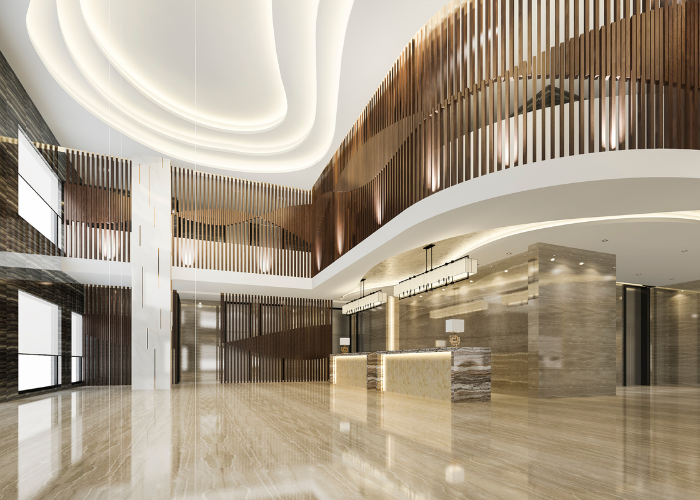The global hotels and resorts market size has expanded over the years, with industry revenues estimated to reach $1.6 trillion in 2024.
But before you can get a piece of the profits, you need to build a resort which is a significant undertaking. After all, it takes a sizable investment and nerves of steel to weather the different challenges along the way.
For starters, building one room in a mid-range resort can cost approximately $20,000 to $40,000. Design errors can take up another 14.2% of the contract value. Expenses add up so it’s important to keep everyone focused on the goal.
Using resort renderings is an innovative way to keep your stakeholders engaged and invested. With professional renderings, the right strategy, business acumen, and determination, you could enjoy returns between 8% and 14%.
Learn more about the impact of photorealistic renderings with Plus Render:
What Is a Resort in Architecture?
In architecture, a resort is characterized as a recreational facility that provides habitable and welcoming accommodations. They’re designed and developed in places with natural beauty—along sprawling beaches, surrounded by national parks, or near mountain ranges and forts.
How To Plan and Design a Resort Plan Guide
Here are some factors to consider when designing a resort:
Site Selection
The location has more bearing on the success of a resort than you think. But deciding on a location based on tourist attractions alone won’t cut it.
You must focus on how you plan to integrate the contextual elements in the area and how to manipulate the environment for a comfortable stay. Research also calls for highlighting the height of the structure. It can help highlight compliance with regulatory frameworks.
Concept Development
Develop a concept that aligns with the local culture and history. It must capture the spirit of the region.
You can sketch preliminary ideas by taking inspiration from Roger A. Allen’s hospitality and leisure projects. These revolve around achieving “something different culturally and experimentally.” You can then explore iterations with local materials.
Renders can illustrate their textures and richness so investors and contractors can appreciate your vision to the smallest detail.
Space Planning
There are 882,329 hotel and resort businesses in the world.
The industry is competitive, but you can boost your chances of success with diligent space planning. It maximizes the functionality of the available area, guiding guests effortlessly through various spaces within the resort.
Proper space planning also ensures there is adequate space for your staff to perform their tasks.
You can save on indoor space by incorporating bi-fold doors, outdoor bathrooms, striking vertical gardens, and organic architecture.
Contextual Elements
A resort is a destination in itself. Successful resorts rely on contextual elements to lure visitors in with the promise of an enriching experience.
For example, if you’re designing a resort in Italy, Greece, Spain, or France, consider the defining characteristics of the Mediterranean style. You can incorporate arches, archways, red terracotta roof tiles, sprawling facades, stucco finishes, and wrought-iron accents.
Interior Design
To deliver the best guest experience in a soothing environment, architects and designers must find ways to enhance the resort’s interiors.
But first, you have to zero in on your audience.
If you’re catering to honeymooners, the focus will be on creating a romantic and intimate vibe with plush furnishings, soft lighting, and velvet curtains that offer a sensual feel.
If you’re marketing your resort as a family-friendly destination, you’ll need to strike a balance between functionality and aesthetics. Think about interconnected rooms for children.
Accessibility
Offer accessible services for the elderly and people with diverse needs.
This can boost your revenue as those with mobility challenges spend $58.2 billion a year on travel. Meanwhile, 70% of vacationers prefer accommodations that support inclusivity even if they cost more.
For a compliant and disability-friendly resort, add clearly marked entry and exit points, visual alarms, lift controls and signage in braille, wheelchair ramps, and low or no thresholds.
Landscape
First impressions set the tone for guests’ experience to the point where they affect where they choose to vacation.
Deliver a powerful first impression by curating a well-designed landscape. Glam it up with native bird-attracting trees, flexible lawn spaces, and water features that emphasize the beauty of the natural surroundings.
The key is to create a serene, tranquil, and aesthetically appealing place that will allow you to retain guests. If they’re happy with their experiences, they’ll reward you with glowing reviews on travel websites and search engines like Google.
Resilience
Disasters like landslides, tsunamis, floods, and earthquakes are legitimate threats to resorts. Ensure that your establishment can weather natural catastrophes with a few proactive measures.
This may include intelligent building systems that detect potential threats early and self-healing materials that recover their original properties. You can refer to the International Building Code (IBC) and Federal Emergency Management Agency (FEMA) Guidelines to look into this further.
Guest Experience
If you’re pitching a project located in the countryside and some distance away from all the action, explore how you can keep guests entertained during their stay.
Focus on your lounging areas, water sports activities, courtyards, and pools. Incorporate variations based on the climatic conditions in the area. You can also offer spa services and wellness retreats.
That said, remember that customer expectations rapidly evolve with changing market trends. Hence, it’s best to create a classic design that stands the test of time so you won’t need to keep changing your resort.
Sustainable Design Principles
Seventy-eight percent of travelers said they plan to stay in eco-friendly accommodations at least once. Hence, going green does more than minimize your ecological footprint. It also puts good money in your pocket.
You can integrate concepts like energy-efficient lighting and appliances, low-flow fixtures, natural ventilation, rainwater harvesting, and passive solar design. You should also consider using eco-friendly materials in construction and furnishing.
Use Resort Renderings To Sell Your Vision
Resort renderings bring your vision to life by digitally depicting what the final resort will look like.
The 3D render provides accurate visualization of even the tiniest details. This empowers business owners to convey the most complex design ideas without going into too many technical specifications.
It also greatly diminishes the risk of errors while offering the flexibility of easily fixing common design issues. Whether it’s furniture that doesn’t blend with the room, the misuse of space, or poor lighting, these issues can easily be modified to reflect last-minute changes.
When resort renderings are done right, people who see them will long to be there. They can elicit emotions and influence desire.
Large Resort Renderings Vs Smaller Types of Renderings
The level of complexity grows with the scale of the project. So, you can imagine how large resort renderings are many times more intricate and multi-faceted than residential projects.
While residential renders deal with one structure and a few rooms, resort renderings must take into account hallways, restaurants, cafes, bars, hotel rooms, pools, spas, driveways, parking areas, and more.
Despite so many elements, they must all be tied together and create a unified seamless experience.
Residential renderings can take 2 to 3 days to develop. Resort renderings, on the other hand, take hundreds of hours.
To ensure the best image resolution, professionals select the best width, height, and optional pixels per inch (PPI) and dots per inch (DPI). It has more pixels so rendering time is long and costly. It also uses more video random access memory (VRAM) to process and display renderings without latency or crashes.
Plus Render: For Breathtaking Resort Renderings
Building a resort is an exciting prospect. Investors, designers, architects, and contractors all have high expectations. Share your vision with professional resort renderings made by Plus Render, a global architectural visualization 3D rendering firm.
From aerial views to the detailed depiction of important areas like the lobby, restaurant, and rooms, Plus Render can help you take their breath away.Book a call to learn more about what we can do for you.







